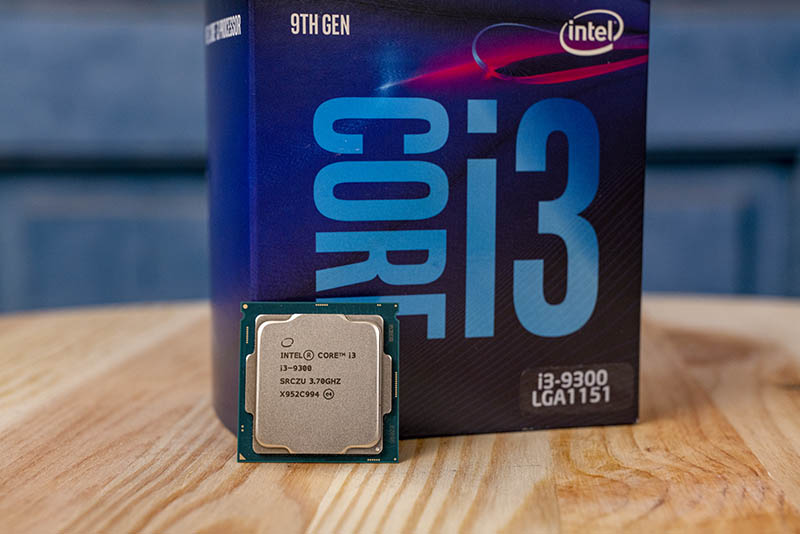Intel Core i3-9300 Power Consumption
We wanted to post a few figures from our testing that show the real selling point of the chips, low power.
- Idle Power (Performance Mode): 31W
- STH 70% Load: 77W
- STH 100% Load: 94W
- Maximum Observed Power (Performance Mode): 106W
Note these results were taken using a 208V Schneider Electric / APC PDU at 17.7C and 72% RH. Our testing window shown here had a +/- 0.3C and +/- 2% RH variance. 120V powered systems will run with more power.
The significance here is that these chips can safely be run in even 1A/120V colocation so long as the configuration is reasonable.
Intel Core i3-9300 Market Positioning
Thes chips are not released in a vacuum instead, they have competition on both the Intel and AMD sides. When you purchase a server and select a CPU, it is important to see the value of a platform versus its competitors.
The AMD side is still less competitive here. AMD’s embedded EPYC 3000 series performs well but is targeted at more cores/ threads, lower TDP, more expansion, and features like 10GbE. Chips such as the AMD EPYC 3151 are designed to serve a different set of customer requirements so it is not really a direct competitor.
With the ASRock Rack X470D4U and variants thereof, we can now put low cost and high-performing desktop Ryzen chips in a server platform. This is much like Intel enables with the Core i3 line servicing both the workstation and server market. The key difference is that we are talking about one motherboard line from one relatively small vendor supporting AMD Ryzen in that way. It shows what is possible, but this is still not enough to be a real alternative on the server-side. Now, on the desktop side, which is part of the Core i3 story, AMD Ryzen is extremely competitive as we showed. There the competition is so strong that Intel is responding with adding Hyper-Threading in this segment in the subsequent 10th Gen Intel Core i3 series.

On the Intel side, looking at the Core i3-9100F, there is better segmentation than one may expect. For $50 or so more one gets a clock speed bump, more cache, and an iGPU. We could debate the exact value of those upgrades, but it seems like a reasonable feature upgrade for the price.
Looking at the Intel Xeon E-2224 which is also a 4 core/ 4 thread part, things are less clear. While the Xeon E-2224 has 300MHz higher boost clock speeds, it also has 300MHz lower base clock speeds than the Core i3-9300. We saw that performance between the two was relatively close. That leaves us with a $50 premium for a similar core, thread, cache, and clock speed feature set but no iGPU. If you simply need support for the small number of features, such as TXT or DDR4-2666 v. DDR4-24400 memory, that the Xeon E-2224 support, then this makes sense. Otherwise, it is fairly difficult for us to recommend the Xeon E-2224 over the Core i3-9300 from what we have seen in our testing.
Final Words
The Intel Core i3-9300 is a solid case of where we probably hypothesized wrong. We thought it was going to be an unnecessary SKU differentiation in the stack. While some may debate if Intel indeed needs so many SKUs, what is fairly clear is that it is going to be a better value for many of our readers than the Xeon E-2224. Likewise, we think that it offers enough to justify the price upgrade over the Core i3-9100F if you need additional performance and features.
While less impact on the server side due to ecosystem limitations, the AMD Ryzen is really the other story here. The AMD Ryzen 5 1600 AF does not have the iGPU but offers a lot more performance at a lower price. Until we see Dell, HPE, Lenovo, QCT, Supermicro, and other large vendors support Ryzen in servers, this part is not an immediate threat to the Core i3-9300 series. When we look at the other use for a Core i3-9300, the workstation market, AMD Ryzen has Intel under siege on a price/ performance/ feature basis which is why Intel is making big shifts in its next-gen parts.
We hope competition in this market brings about some of the rapid innovation that we have seen in other segments. It is long overdue for disruption. In the meantime, if you are looking at current server sockets, then the Core i3-9300 is a chip that will make a lot of sense to many of our readers.




Reading this review today I feel like you guys are releasing these in some kind o’ order. You’re releasing this just ‘co-incidentally’ a few days after your X470D4U Ryzen server review? I don’t buy it. You’re ordering these reviews on purpose.
RedManFam – If you are suggesting that we have a content plan, I can assure you we do. It gets updated (often) as new developments occur, but there is a plan.
FYI, Intel has disabled ECC in the new i3s.
Hello. Could you please verify this CPU is vulnerable to Meltdown? Intel lists is as B0 revision what might be the same B0 as Kaby Lake. Thank you.
Powershell script:
https://support.microsoft.com/en-us/help/4073119/protect-against-speculative-execution-side-channel-vulnerabilities-in
For a home server I am looking for a setup with low power consumption while the CPU is idle, as I am assuming that this is the most important figure concerning power costs. Comparing this article with the earlier test of the G5400 the idle power consumption differs by 6W! The article says that the same board was used.
May I ask if this was really the same setup? There are so many factors impacting idle power like fans, enabled ports and so on. Is the difference of 2 cores and 2MB cache causing a difference in idle power of 6W? I would also be interested in a comparison with the E-2236. Does anybody have numbers concerning this?